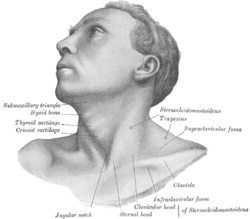Cricoid cartilage
| Cricoid cartilage | |
|---|---|

Anterolateral view of head and neck (cricoid cartilage labeled at center left)
|
|

Antero-lateral view of the ligaments of the larynx (cricoid cartilage visible near bottom center)
|
|
| Details | |
| Precursor | 4th and 6th branchial arch |
| Identifiers | |
| Latin | Cartilago cricoidea |
| MeSH | A02.165.507.211 |
| TA | A06.2.03.001 |
| FMA | 9615 |
|
Anatomical terminology
[]
|
|
The cricoid cartilage /ˌkraɪkɔɪd ˈkɑːrtɪlɪdʒ/, or simply cricoid (from the Greek krikoeides meaning "ring-shaped") or cricoid ring, is the only complete ring of cartilage around the trachea. It forms the back part of the voice box and functions as an attachment site for muscles, cartilages, and ligaments involved in opening and closing the airway and in producing speech.
The cricoid cartilage sits just inferior to the thyroid cartilage in the neck, at the level of the C6 vertebra, and is joined to it medially by the median cricothyroid ligament and postero-laterally by the cricothyroid joints. Inferior to it are the rings of cartilage around the trachea (which are not continuous – rather they are C-shaped with a gap posteriorly). The cricoid is joined to the first tracheal ring by the cricotracheal ligament, and this can be felt as a more yielding area between the firm thyroid cartilage and firmer cricoid.
It is also anatomically related to the thyroid gland; although the thyroid isthmus is inferior to it, the two lobes of the thyroid extend superiorly on each side of the cricoid as far as the thyroid cartilage above it.
...
Wikipedia
